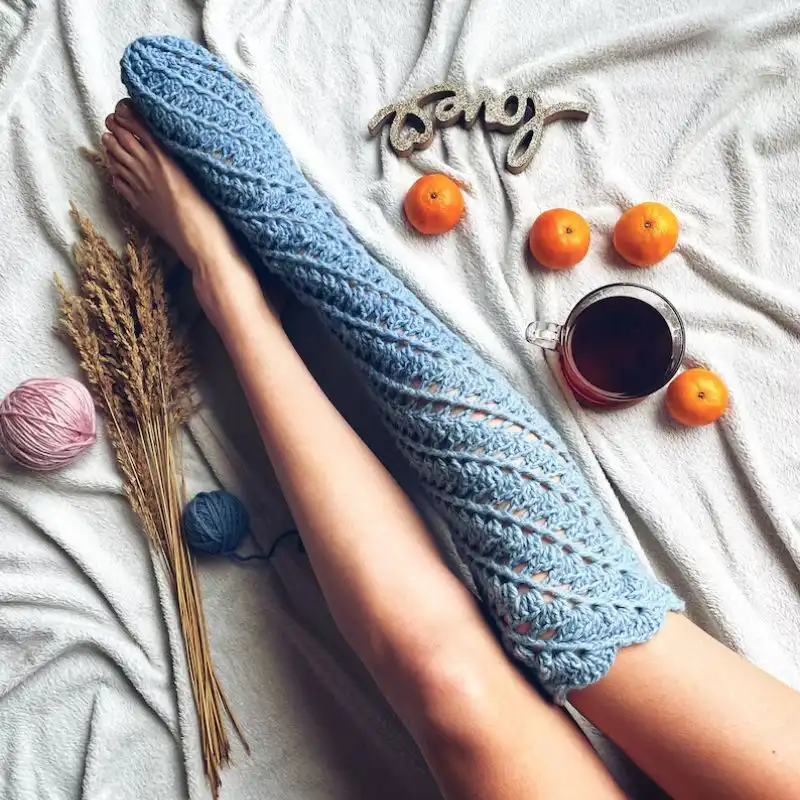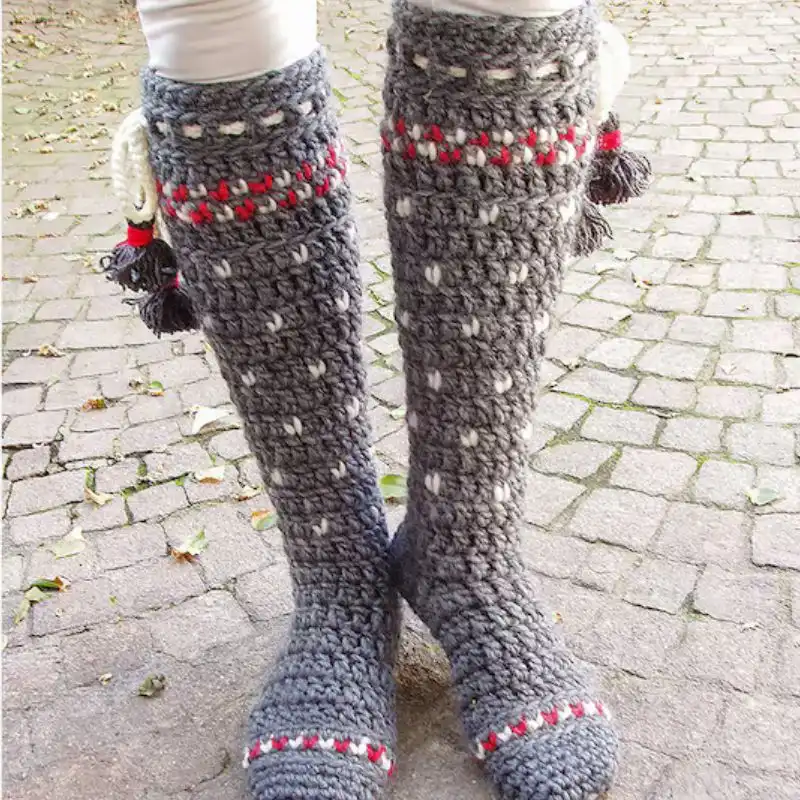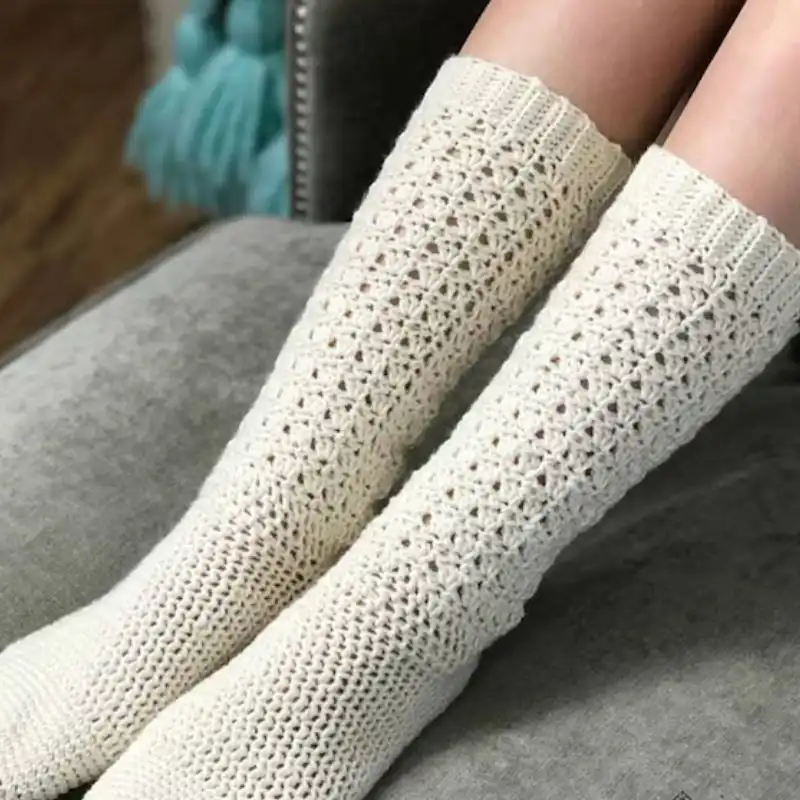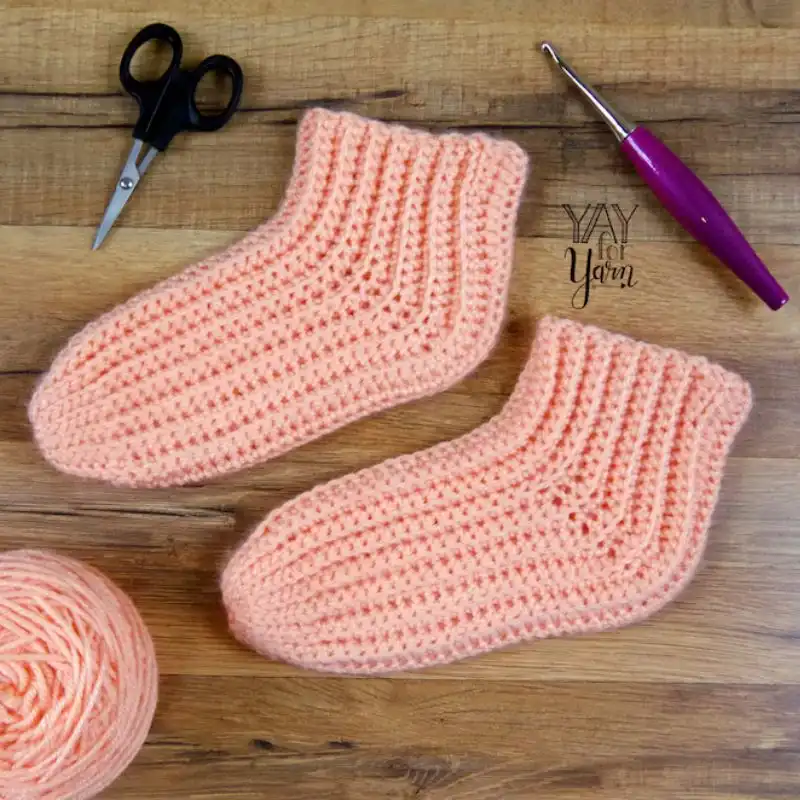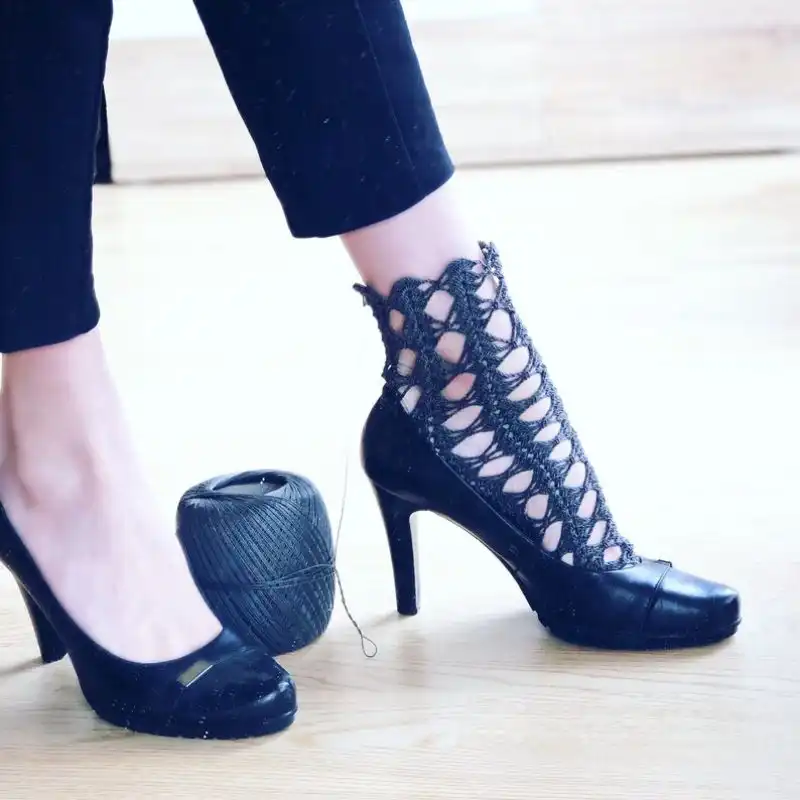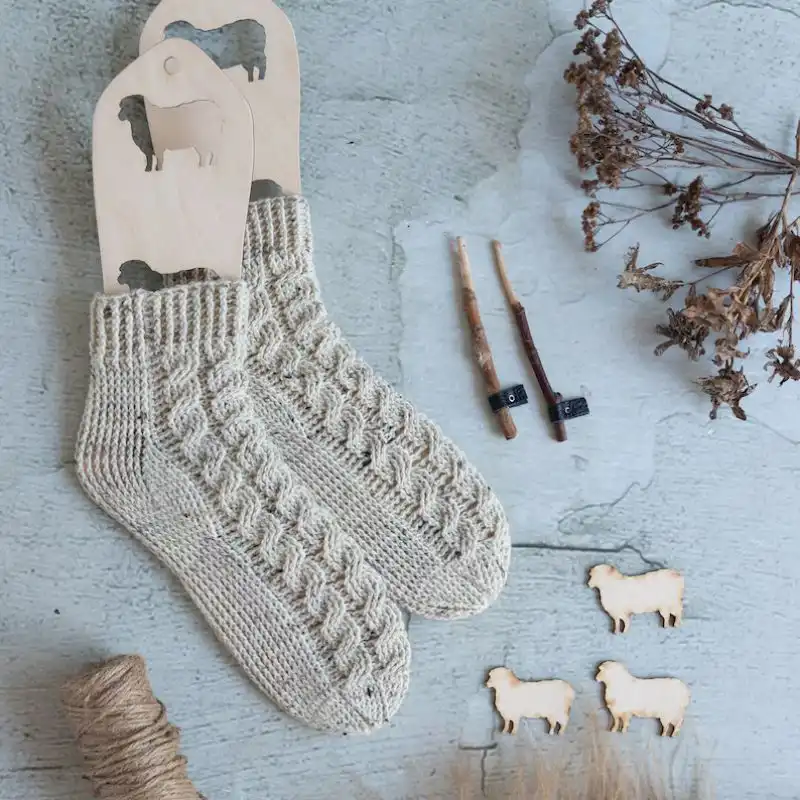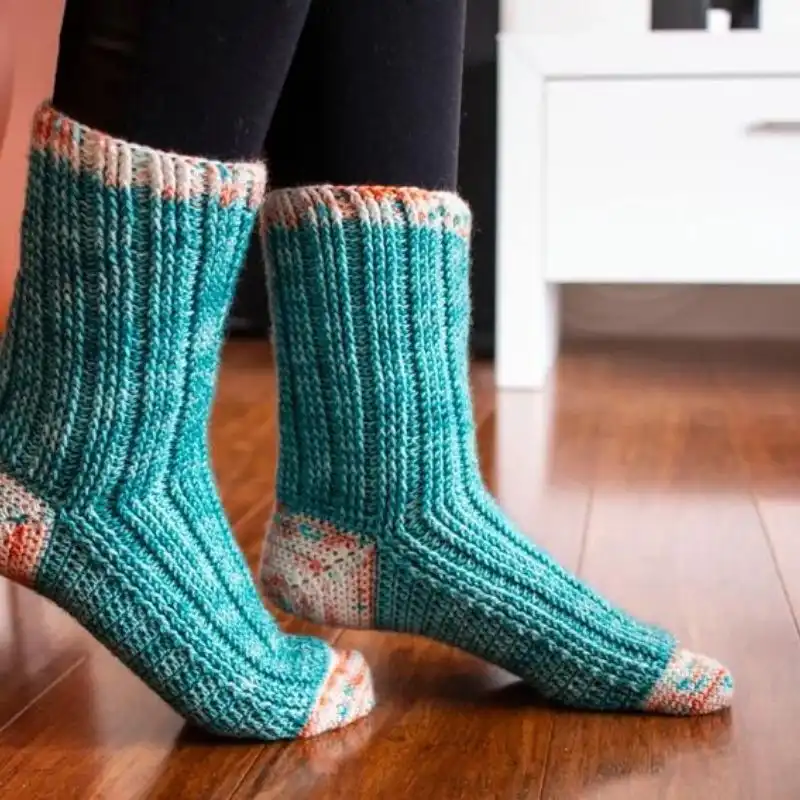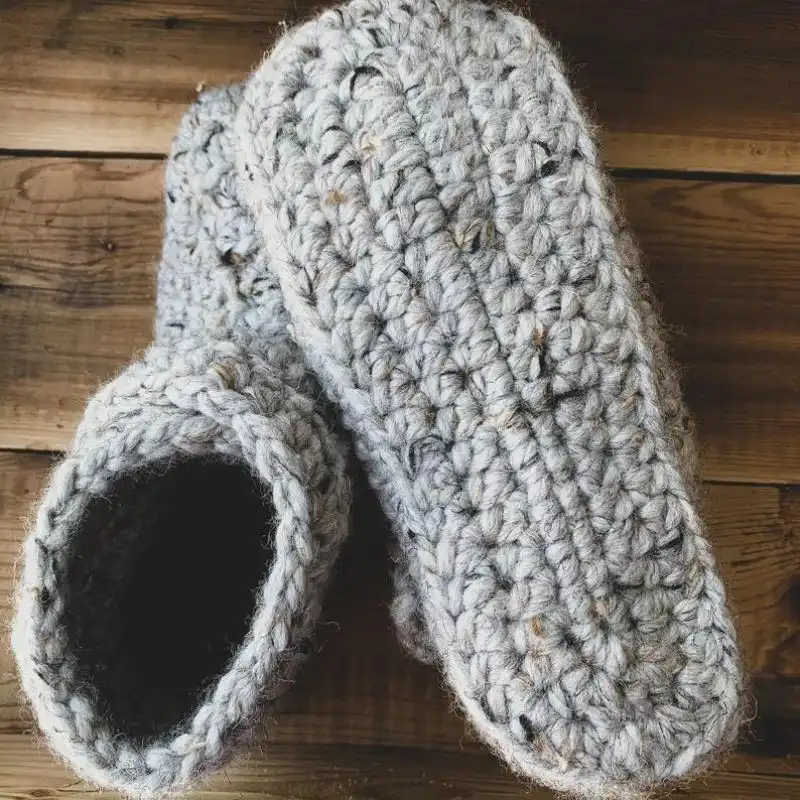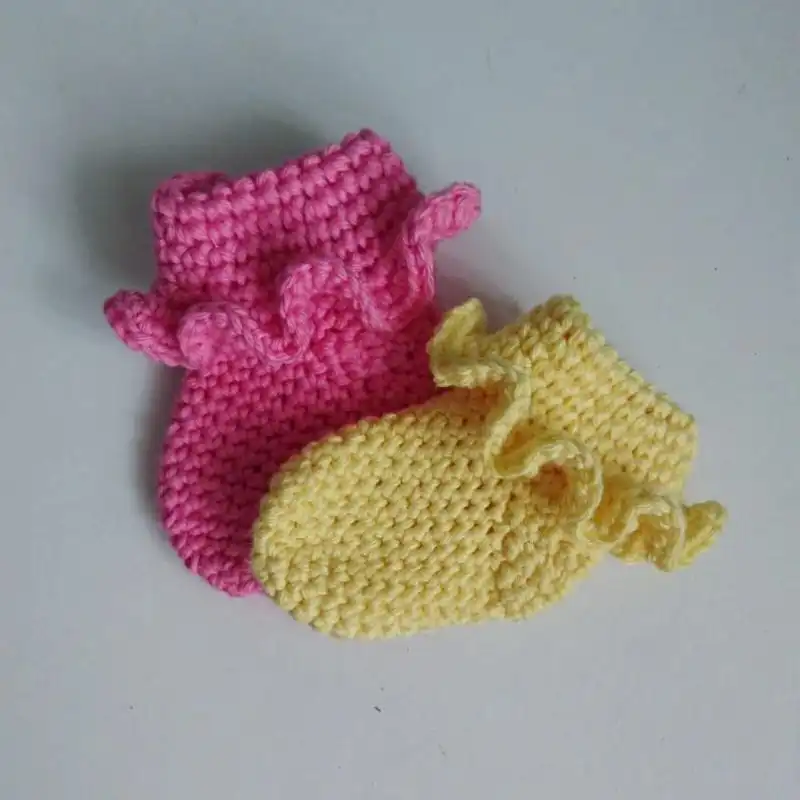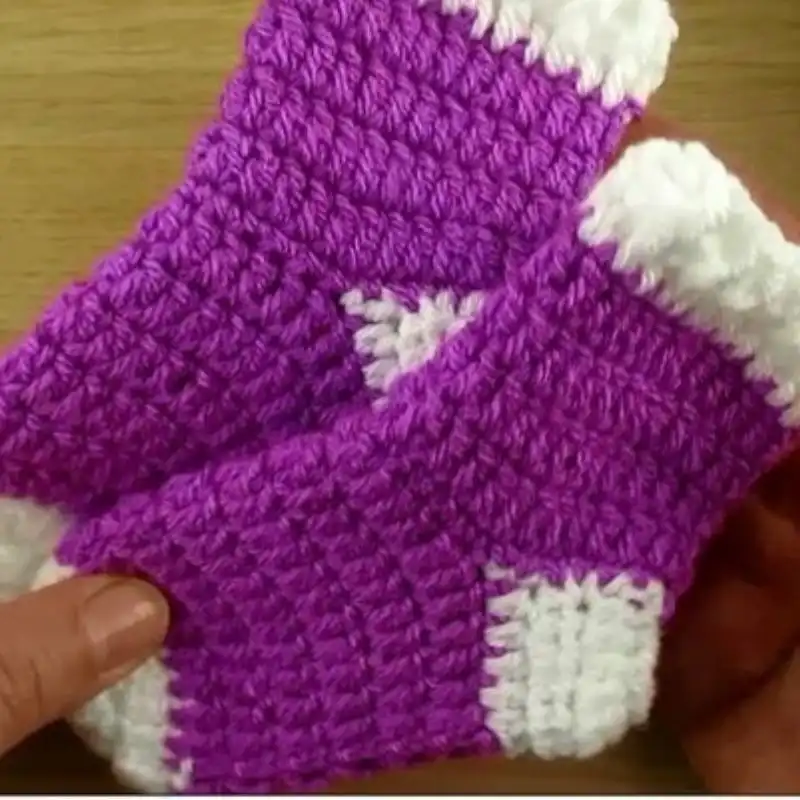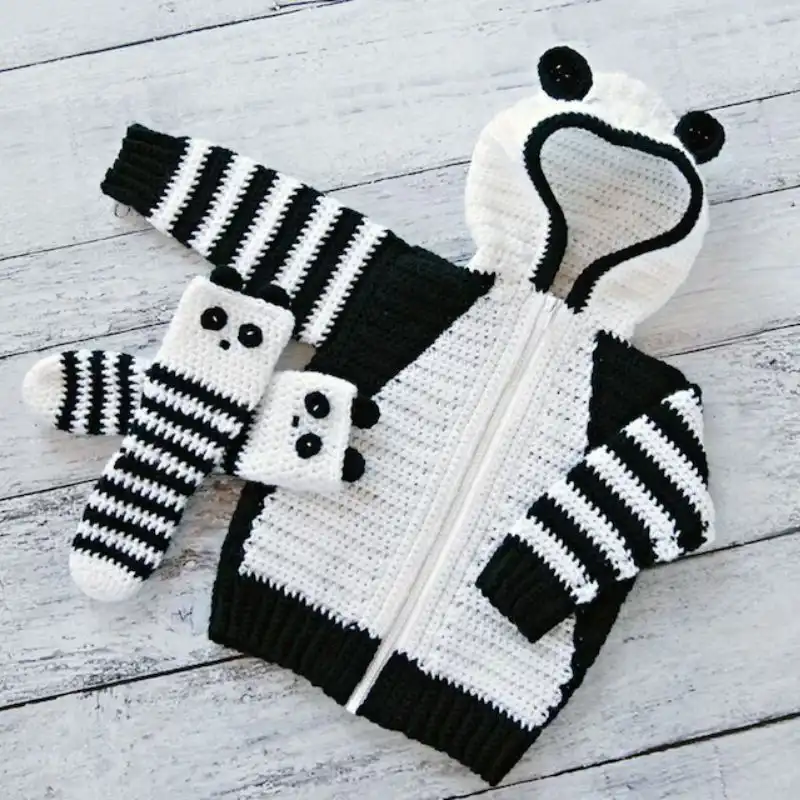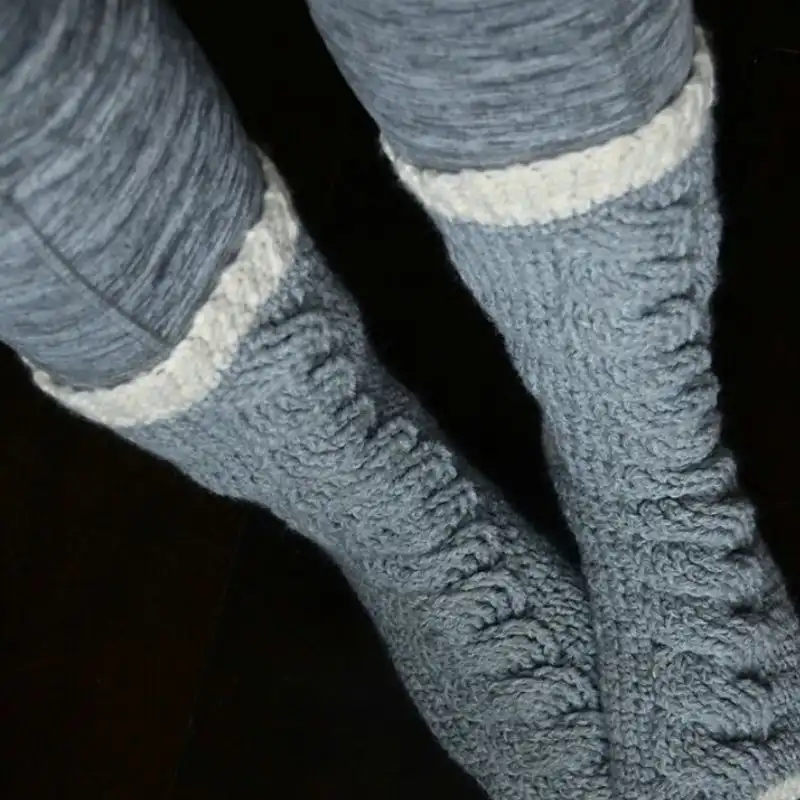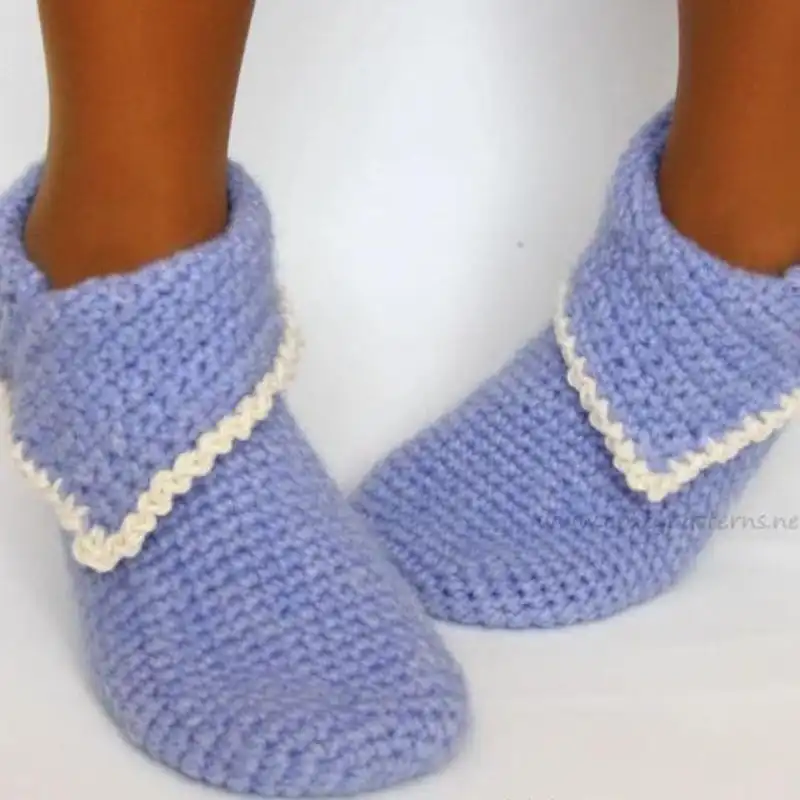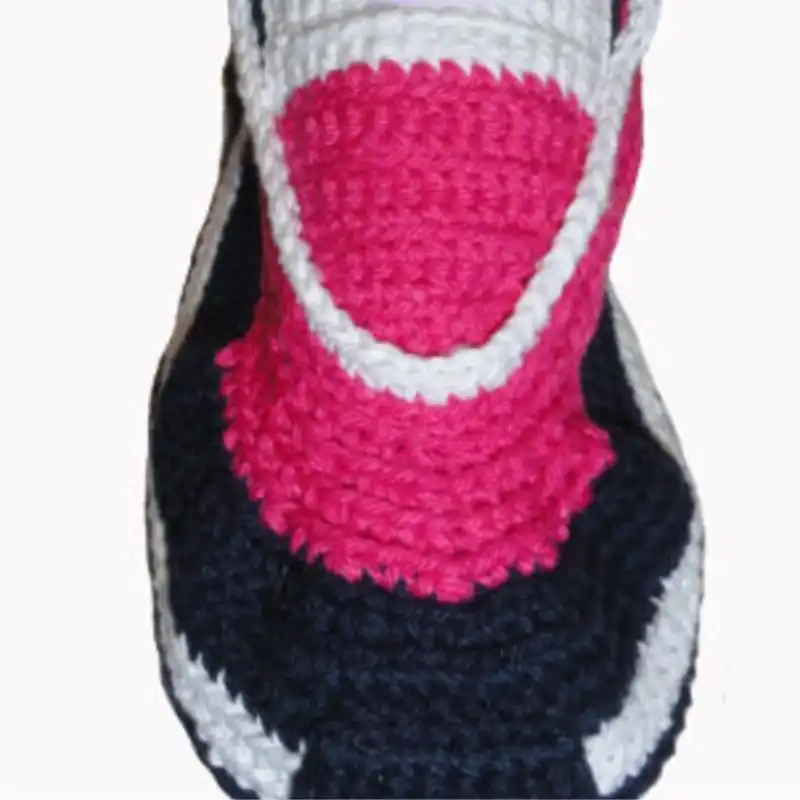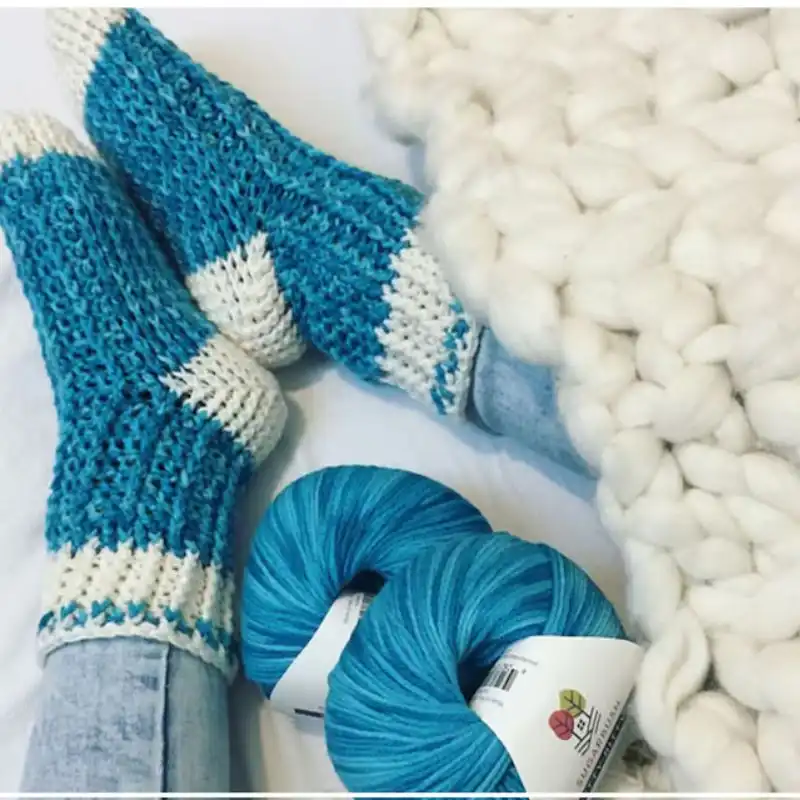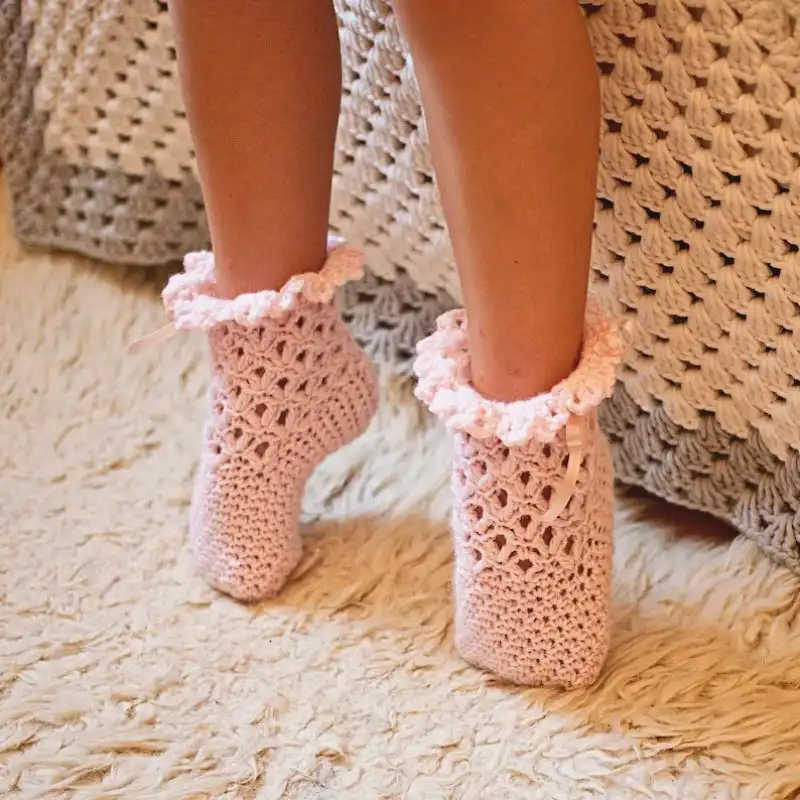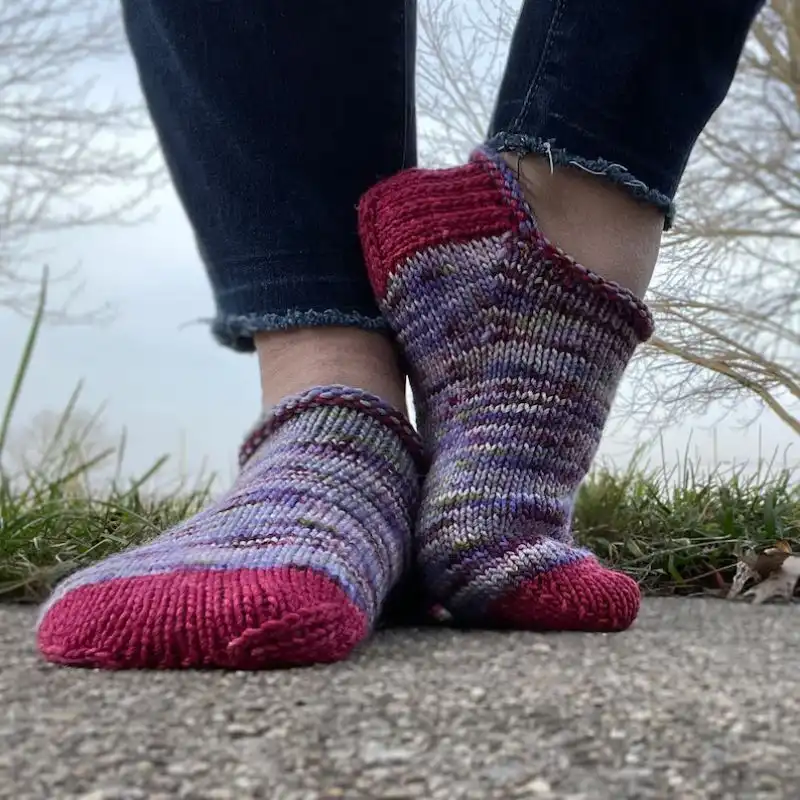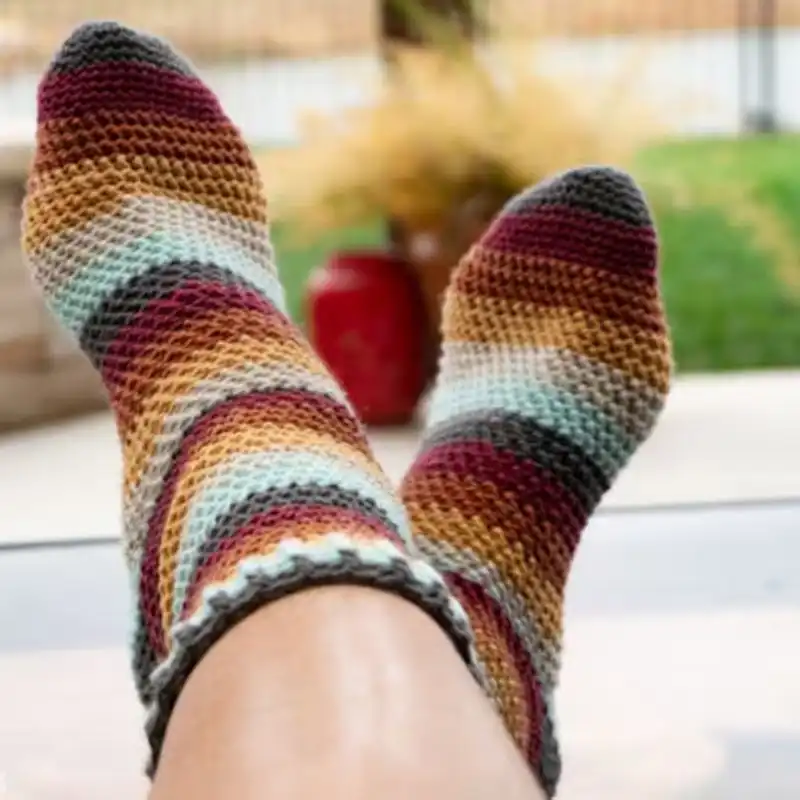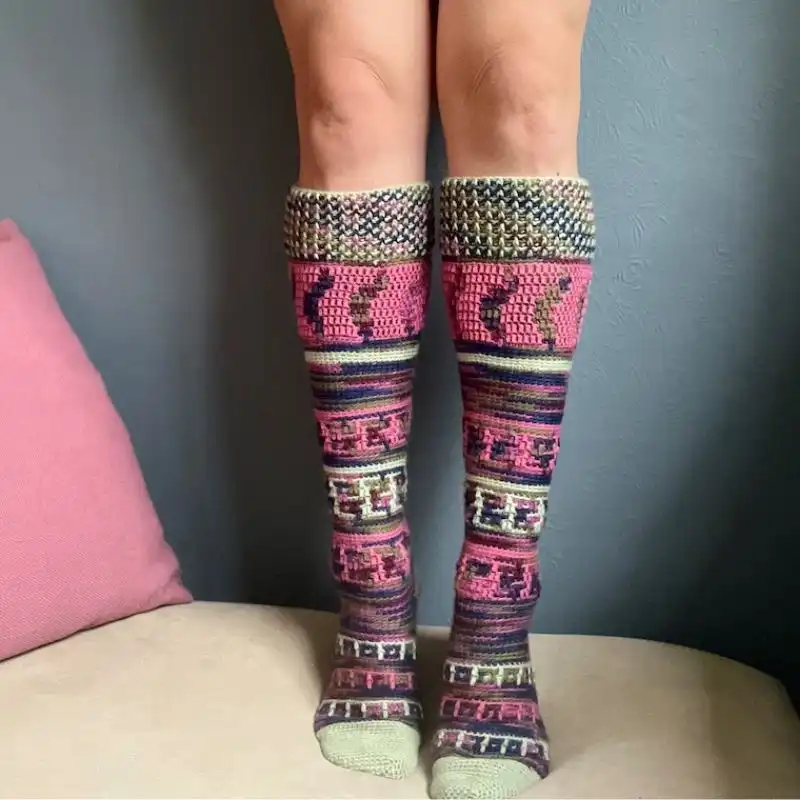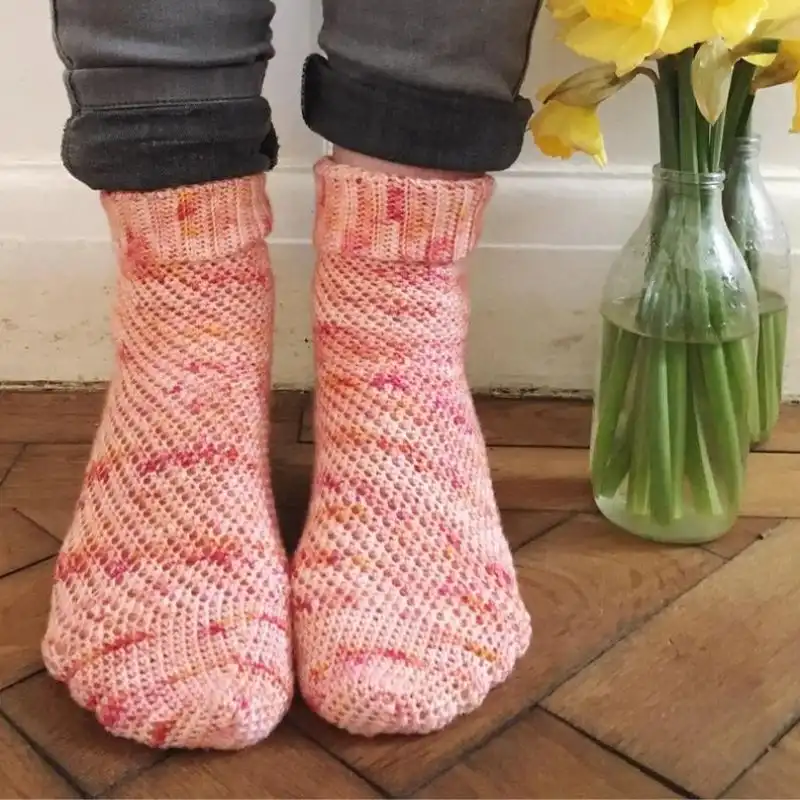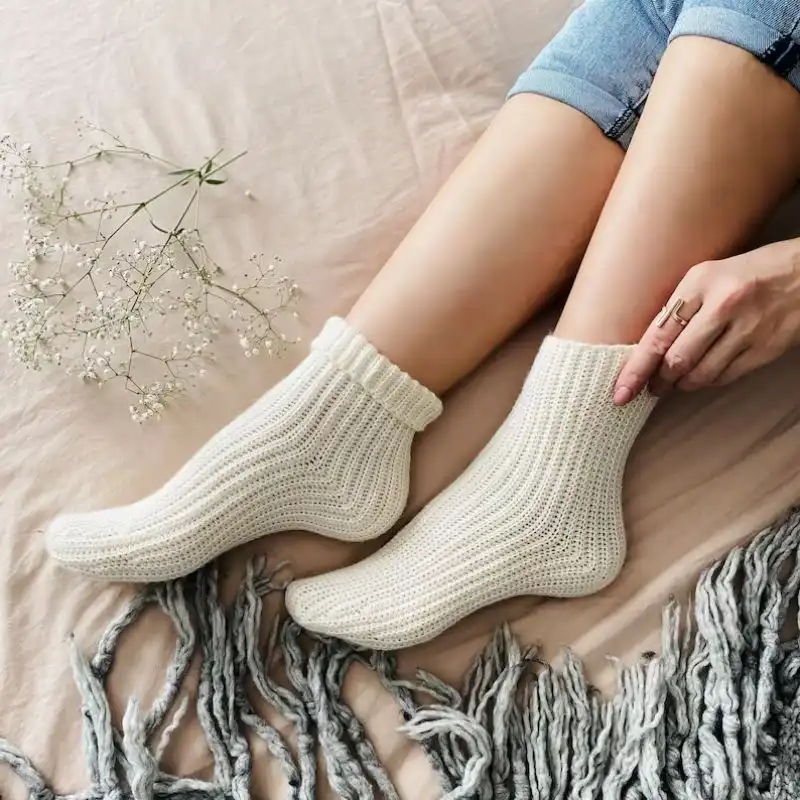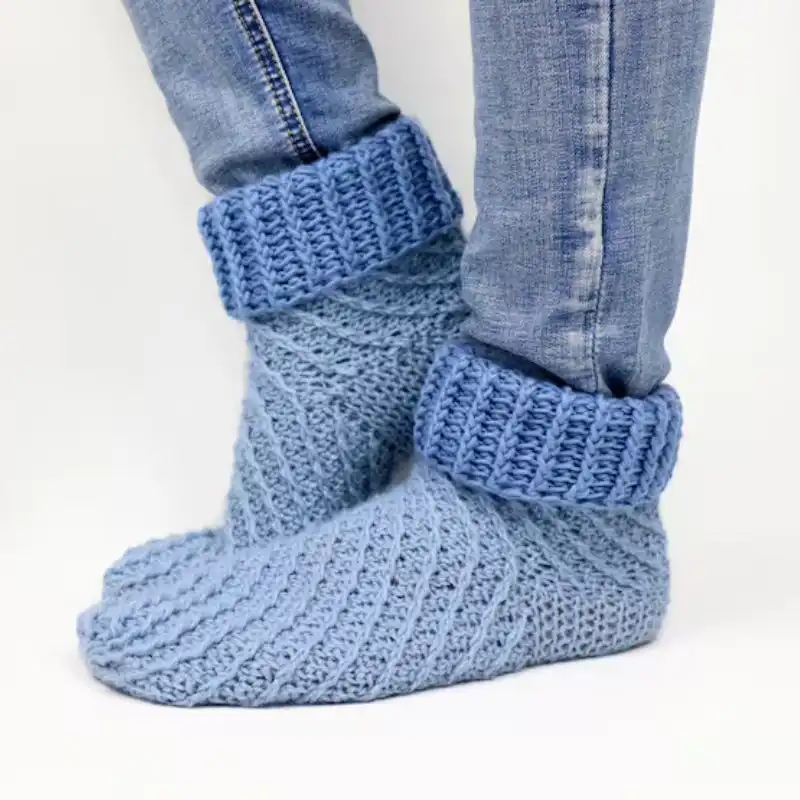In winter there is nothing better than a warm and cozy pair of socks, especially when you know they are handmade. Usually, when we think of socks, we think they are knitted but thanks to the many variations of yarn, crochet hook sizes, and interesting patterns, you can make a pair of crochet socks just right for you.

Quick and easy, most patterns for crochet socks are for slipper socks which can be worn only around the house, but you will find a few options with the right choice of yarn which can also be worn outside.
Whether you are looking for comfy winter warmers, elegant ladies socks, baby socks, yoga socks or simply a personal gift for friends and family, these small items of clothing can make a great beginner project.
Is It Worth To Crochet A Socks?
The worthiness of crocheting socks can depend on various factors such as your time, skill level, interest in the project, and need for a unique or specialized pair of socks. Here are some pros and cons to consider:
Pros
- Customization: You can choose your yarn, color, and pattern to create a pair of uniquely yours socks.
- Quality: Handmade items often last longer and are made to a higher standard than mass-produced items, especially if you use quality yarn.
- Skill Improvement: If you are a beginner, a pair of socks is a great project to improve your skills, as it can involve a variety of stitches and techniques.
- Satisfaction: There’s a sense of accomplishment in completing a project from start to finish.
- Gifts: Handmade socks can make warm and personal gifts.
- Therapeutic: Many people find the repetitive nature of crocheting to be relaxing and a good form of stress relief.
- Special Needs: If you have particular requirements for your socks, such as non-standard sizes or extra cushioning, you can incorporate these features.
Cons
- Time-Consuming: Depending on your skill level and the complexity of the pattern, it can be a time-consuming project.
- Cost: Quality yarn and necessary tools can sometimes be expensive.
- Difficulty: Socks can be challenging, involving specialized stitches and techniques like working in the round.
- Practicality: Store-bought socks are quick and easy to replace and are generally less expensive in terms of both time and money.
- Comfort: Not all yarn is comfortable against the skin, so you’ll need to choose carefully.
Popular Stitches For Crochet Socks
Crocheting socks can be a rewarding project, and there are many stitches that can be used to create functional and beautiful socks. Here are some popular stitches that are commonly used in sock patterns:
Basic Stitches
- Single Crochet (sc): Provides a dense fabric, good for the heel or sole.
- Half Double Crochet (hdc): Offers a bit more stretch than single crochet, still quite dense.
- Double Crochet (dc): Creates a looser fabric, useful for the leg part if you want a lighter sock.
Ribbing Stitches
- Front Post Double Crochet and Back Post Double Crochet (FPdc and BPdc): Creates a ribbed texture that can be very stretchy and excellent for cuffs.
- Single Crochet in the Back Loop Only (sc blo): Creates a subtle ribbing, often used for the cuff or the heel.
Textured Stitches
- Shell Stitch: The shell stitch adds a lacy, feminine touch to decorate socks.
- Puff Stitch: Creates texture but can be a bit bulky; better for casual or slipper socks.
- Cluster Stitch: Similar to puff stitch but less bulky, used for adding texture.
Specialized Stitches
- Linked Double Crochet: Reduces gaps between stitches, creating a denser fabric.
- Extended Single Crochet (esc): Provides more stretch and height than a regular single crochet.
- Slip Stitch: Often used in the heel for added durability.
Stitch Patterns
- Basketweave: Uses a combination of front post and back post stitches to create a textured pattern that resembles a woven basket.
- Waffle Stitch: Uses a combination of double crochet and front post double crochet to create a textured waffle pattern.
- Cables: Created using post stitches, they add visual interest and texture.
RELATED: 41 Free & Unique Crochet Rug Patterns (With Pictures)
Popularity Of Crochet Socks
Crochet socks have seen a resurgence in popularity over the past few years. It is a testament to the general revival of crafting and DIY trends and crochet socks’ unique charm and comfort.
In an era where customization and individuality are cherished, crochet socks’ versatile and expressive nature has hit a chord with many consumers.
Many factors have led to this increased popularity. First and foremost, the rise of social media platforms like Instagram, Pinterest, and TikTok has significantly boosted the visibility and appreciation of handmade crafts.
Here, crochet socks shine due to their vibrant colors, intricate patterns, and potential for personalization. Creators share their designs and finished products, spreading inspiration and a sense of community around the craft.
In terms of practicality, crochet socks offer a unique blend of comfort and warmth. They are softer and more flexible than typical machine-made socks, offering a more luxurious feel.
Additionally, materials such as wool or cotton are known for their breathable properties and can be selected based on the user’s preferences or environmental needs. Crochet socks are trendy when people look for cozy, warm footwear during colder seasons.
How Long Should A Crochet Sock Be?
The length of a crochet sock largely depends on individual preference, its intended use, and who it is for. Here are some general guidelines based on different types of socks:
- Ankle Socks: These socks typically sit at or just below the ankle. They’re often about 1 to 2 inches above the shoe line.
- Crew Socks: These are some of the most common lengths, often coming up 6 to 8 inches above the ankle.
- Mid-Calf Socks: These socks reach halfway up the lower leg and can be around 9 to 12 inches in length from the heel.
- Knee-High Socks: These socks reach all the way to just below the knee. The length can vary but is generally 14 to 20 inches from the heel.
- Over-the-Knee Socks: These socks go above the knee and can be as long as you like, but they typically range from 22 to 26 inches from the heel.
- Custom Length: If the socks are for someone with non-standard sizing needs (for example, extra-large calves or petite legs), you may need to adjust the length accordingly.
Essential Tools & Materials
Here are the vital tools and materials needed for crocheting socks:
- Crochet Hooks: The size of the hook you need will depend on the weight of the yarn you’re using. Sock yarn typically calls for a smaller hook, in the 2.25mm – 3.5mm (B1-D3).
- Yarn: Sock weight yarn is typically used for crocheting socks, but the type of fiber can vary. Wool is a common choice for its warmth and elasticity. However, cotton, bamboo, or blends are also a good choice. Some yarns even come with a bit of nylon for added durability.
- Pattern: There are many sock patterns available, from simple to intricate. Choose one that matches your skill level and the design you have in mind.
- Stitch Markers: These can help mark the start of rounds or key points in your pattern.
- Yarn Needle: Also known as a darning needle, you’ll need this for weaving in ends when you’re done crocheting.
- Scissors: For cutting the yarn.
- Measuring Tape: To check the sizing of the sock, ensuring it will fit the intended wearer. It is essential to start using a pattern or adjusting a design to fit.
- Gauge Swatch: Technically not a tool, but an essential step in ensuring your socks fit properly. Before you begin, crochet a small swatch to check that your gauge (the number of stitches per inch/cm) matches what’s called for in the pattern.
Glossary Of Common Crochet Stitches And Techniques
Here’s a list of some common crochet stitches and strategies you might come across, especially when making crochet socks:
- Chain Stitch (ch): This is the most basic crochet stitch, often used to start a project.
- Single crochet (sc): This is the simplest stitch after the chain stitch, forming a tight, dense fabric.
- Half Double crochet (hdc): This stitch is taller than the single crochet but shorter than the double crochet.
- Double Crochet (dc): A common crochet stitch twice as tall as the single crochet.
- Treble Crochet (tr): This tall stitch is useful when you need to cover a lot of area with fewer stitches.
- Slip stitch (sl st): This is usually used to join rounds or to move your yarn to a different spot without adding height.
- Yarn Over (yo): This involves wrapping the yarn over your hook, an essential part of making many crochet stitches.
- Magic Circle (or Magic Ring): This technique is used to start crocheting in the round, often used when making socks, hats, or amigurumi.
- Stitch Marker (sm): Not a stitch, but a tool used to mark your place in a round or row.
- Increase (inc): This technique involves making more than one stitch in the same stitch from the previous row to widen the piece.
- Decrease (dec): This technique combines two or more stitches from the previous row into one stitch to narrow the piece.
- Working in the Round: This is when you crochet in a continuous spiral, often used for socks, hats, and amigurumi.
- Working in Rows: You crochet back and forth, turning your work at the end of each row.
- Front Loop Only (FLO): Crocheting into the front loop only of the stitch from the previous row, leaving the back loop unworked.
- Back Loop Only (BLO): Crocheting into the back loop only of the stitch from the previous row, leaving the front loop unworked.
- Gauge refers to the number of stitches and rows in a specified measurement (usually 1 inch or 4 inches/10 cm). Matching the gauge given in a pattern is crucial to ensure correct sizing.
Understand Crochet Stitches & Techniques
Understanding crochet stitches and techniques can be challenging when you’re first starting. Here are some tips to help you navigate this aspect of the craft:
- Start With Basics: Before you try to learn more complex stitches and techniques, ensure that you’ve mastered the basics, such as chain stitch, single crochet, and double crochet. These form the foundation of most crochet projects.
- Use Online Resources: Many helpful tutorials, diagrams, and videos online can help you understand how to perform each stitch or technique. Sites like YouTube offer step-by-step visual guidance that can be extremely helpful.
- Practice Regularly: The best way to understand crochet stitches and techniques is by doing them. Practice regularly to build muscle memory. You can make small practice swatches focusing on a particular stitch or technique.
- Read Patterns: Reading crochet patterns can help you understand how different stitches and techniques are used in context. Start with simple designs and work your way up to more complex ones.
- Use Stitch Markers: These can be incredibly helpful when keeping track of where a round begins and ends or when you need to note a particular place in the pattern.
- Swatch for Gauge: This is crucial for ensuring your final product is the correct size. Please make a small sample (known as a swatch) using the stitch specified in the pattern, and compare it to the gauge provided in the pattern instructions.
- Join a Community: There are many online communities where you can ask questions and get help from more experienced crocheters. It is beneficial when stuck on a particular stitch or technique.
- Be Patient: Like any new skill, crocheting takes time to master. Keep going even if you don’t understand something right away.
- Document Your Learning: Take notes or photos of your work, particularly if a stitch or technique is challenging. It will make it easier to remember how to do it next time.
Understand Yarn Weights And Hook Sizes
Different stitches and techniques may work better with certain yarn weights and hook sizes. Make sure you understand how these factors can affect your final product.
Which Yarn Is Best For Crochet Socks?
Choosing the right yarn for crochet socks can significantly impact the final product’s comfort, fit, and durability. While you can technically use yarn to crochet socks, some types are more suitable. Here are a few common options:
- Wool: Wool is popular for crochet socks due to its warm and elastic properties. It is breathable and wicks moisture away from the skin, which is crucial for foot comfort. Merino wool, in particular, is known for being exceptionally soft and fine, making it great for socks.
- Wool Blends: These yarns combine the benefits of wool with other fibers. A common blend for sock yarn is wool and nylon, which provides the warmth and breathability of wool with the added durability of nylon. This blend can withstand the wear and tear that socks often endure.
- Cotton: Cotton is breathable and absorbent, making it a good option for lighter summer socks. However, it lacks the elasticity of wool, so cotton socks may not hold their shape as well over time.
- Bamboo: This is another option for lightweight, breathable socks. Bamboo yarn is soft, cool, and has a slight sheen. It’s also naturally antibacterial. However, like cotton, it lacks elasticity, so it may not be the best choice for socks that need to maintain a snug fit.
- Acrylic: While not as breathable as natural fibers, acrylic is durable and machine-washable, making it a practical choice. It’s also an affordable option and comes in various colors.
How Much Yarn Do I Need To Crochet Socks?
The amount of yarn you’ll need to crochet a pair of socks depends on several factors, including:
- The size of the socks: A pair of socks for a child will require less yarn than a pair of adult-sized socks. Larger sizes or longer socks (like knee-highs) will need more yarn.
- The stitch pattern: More complex patterns may use more yarn than simple ones. For example, a sock with a basic single or double crochet stitch will likely use less yarn than an intricate lace or cable pattern.
- The weight of the yarn: Sock-weight yarn is most commonly used for crochet socks, but the amount needed will vary if you’re using a different weight.
- The density of the stitches: If you crochet very tightly, you may use more yarn than if you crochet more loosely.
As a general guideline, you will likely need between 350 to 400 yards (320 to 366 meters) of yarn for a pair of average adult-sized socks crocheted with sock-weight yarn. It can vary, so checking your pattern for specific yardage requirements is always a good idea.
How To Determine The Size For Crocheting The Socks?
Determining the correct size for crochet socks requires some careful measurement and planning. Here’s a step-by-step guide:
- Measure the Foot: Using a flexible measuring tape, measure the circumference of the widest part of the foot (usually around the ball of the foot) and the length from heel to toe. If the socks are not for you, try to get these measurements from the intended wearer.
- Check the Pattern: Most sock patterns will provide size guidelines based on foot measurements. They’ll tell you how many stitches per inch/cm (gauge) you should aim for and provide instructions for different sizes.
- Make a Gauge Swatch: Before you begin, it’s important to make a gauge swatch to check your stitch size. It involves crocheting a small square using the stitch specified in the pattern. Once complete, measure the number of stitches and rows in an inch or 4 inches/10 cm square. If it matches the pattern’s gauge, you’re good to go. If not, you might need to adjust your hook size or tension.
- Adjust if Needed: If the intended wearer has particularly wide or narrow feet or between sizes, you might need to adjust the pattern. For example, you might need to add or remove stitches to alter the width or add or remove rows to modify the length.
- Try as You Go: One advantage of crocheting socks is that you can try them on as you go, as long as you make them yourself. It will help you make sure they’re the right size.
Is It Beginner Friendly?
Crocheting socks can be a more complex project because it involves working in the round, shaping (increases and decreases), and potentially more intricate stitches. However, that does not mean it’s impossible for beginners – it might be challenging as an absolute first project.
If you’re a beginner looking to crochet socks, here are some tips:
- Start with simpler projects first: Before jumping into socks, try a few simpler projects to get the hang of the basic stitches and techniques. Starting with items like dishcloths, scarves, or even hats can gradually help you build your skills.
- Choose a simple sock pattern: Plenty of beginner-friendly sock patterns exist. Look for one that uses basic stitches and has a straightforward construction.
- Use YouTube and other resources: There are tons of video tutorials out there that can guide you through crocheting socks. It can be helpful when you’re getting used to working in the round or shaping the heel and toe.
- Practice patience: Like any new skill, crocheting socks will take some time to master. Keep going even if your first pair isn’t perfect. Every project is an opportunity to learn and improve.
Don’t be afraid to ask for help: There are many online crochet communities where you can ask questions and get advice from more experienced crocheters. Feel free to reach out if you’re having trouble.
You can make very simple crochet socks or you can make more ornate crocheted socks. Here are our best 39 patterns for crochet socks and slippers.
How To Crochet A Basic Beginner-Friendly Socks?
Crocheting a basic pair of socks is a manageable project for beginners. Here’s a simple guide to help you make an adult-size pair of basic, ankle-length crochet socks. Please note that this is just a general outline, so adjust as needed for your specific yarn, crochet hook size, and intended fit.
Materials Needed
- Worsted weight yarn (approx. 300-400 yards)
- 5.0 mm crochet hook (or size needed to meet gauge)
- Yarn needle for weaving in ends
- Stitch markers
Gauge
- Around 4 stitches and 4 rows = 1 inch in single crochet. Adjust your hook size if needed to meet the gauge.
Stitches Used
- Chain (ch)
- Slip Stitch (sl st)
- Single Crochet (sc)
- Half Double Crochet (hdc)
Size
- Adult Medium (Adjust the pattern for other sizes by increasing or decreasing stitches evenly)
Instructions
Cuff
- Chain 11.
- Row 1: Sc in 2nd ch from hook and each ch across, ch 1, turn. (10 sc)
- Rows 2-40: Sc in back loop only across, ch 1, turn.
- After Row 40, join the first and last rows with slip stitches to form a circle. This forms the cuff.
Leg
- Round 1: Work 40 sc evenly around the edge of the cuff. Join with a sl st.
- Rounds 2-10: Ch 1, sc in each stitch around. Join with a sl st.
Heel Flap
- Row 1: Ch 1, sc in the next 20 stitches, turn.
- Rows 2-10: Ch 1, sc in each of the 20 stitches, turn.
- Do not fasten off. You’ll now proceed to turn the heel.
Turn Heel
- Row 1: Ch 1, sc in first 11 stitches, turn.
- Row 2: Ch 1, sc in first 6 stitches, turn.
- Row 3: Ch 1, sc across to within one stitch of the previous row, and turn.
- Repeat Row 3 until all heel stitches are worked, ending on a wrong side row.
Gusset And Foot
- Pick up about 10 stitches along the side of the heel flap, sc in each stitch across the top of the foot, then pick up another 10 along the other side of the heel flap.
- Round 1: Sc in each stitch around.
- Round 2: Sc2tog at the beginning and end of the stitches picked up on both sides of the heel flap, sc in each other stitch around.
- Repeat Rounds 1 and 2 until the total stitch count is back to 40 stitches.
Toe
- Round 1: Sc in each stitch around.
- Round 2: [Sc2tog, sc in next 8 stitches] repeat 4 times.
- Repeat Rounds 1 and 2 until 20 stitches remain.
- Continue with sc2tog around until 10 stitches remain.
- Fasten off, leaving a long tail. Use this tail to sew the remaining stitches together and weave in the end.
36 Adults Crochet Socks Patterns
1. Basic Crochet Socks Pattern
We start off with a pattern for a basic crochet sock design perfect for beginners. Quick and easy, you work this pattern in single crochet only. If you use a rainbow yarn, you can create a truly individual pair of socks.
Suggested Yarn: Acrylic or Wool Blend
Difficulty Level: Beginner
Yarn Weight: Worsted (Medium 4)
Needle Size: 4.0 mm (G-6)
2. Thigh-High Twirling Toe Crochet Socks Pattern
This step-by-step instruction pattern for twirling toe crochet socks includes different sizes, and even how to turn these originally thigh-highs into shorter socks.
As this pattern uses front post double crochets, it is an intermediate design but also worth a challenge for a crochet beginner. The intricate effect of lace wrapping around the leg could make this pair of socks a handmade gift for someone special.
Suggested Yarn: Cotton or Bamboo
Difficulty Level: Intermediate
Yarn Weight: Worsted (Medium 4)
Needle Size: 5.5 mm (I-9)
3. The Flat Crochet Socks
With an option for a thinner or wider foot, this pattern for the flat crochet socks can be easily adjusted to your foot size.
You can use either two colors or stick with one color for the socks. For the texture of the socks to come out better, it is best to use a darker color.
Suggested Yarn: Merino Wool or Alpaca
Difficulty Level: Advanced
Yarn Weight: Worsted (Medium 4)
Needle Size: 4.5 mm
4. Lillehammer Knee-High Socks Crochet Pattern
The Lillehammer Knee-High Socks crochet pattern features a cozy and stylish design, perfect for keeping your feet warm during chilly days. These socks are worked from the cuff down, allowing you to customize the length to your preference.
The pattern incorporates basic crochet stitches such as single crochet, double crochet, and slip stitch, making it suitable for intermediate crocheters. With its textured stitch pattern and ribbed cuff, these knee-high socks are both functional and fashionable.
Suggested Yarn: Wool or Wool Blend
Difficulty Level: Intermediate
Yarn Weight: Worsted (Medium 4)
Needle Size: 5.0 mm (H-8)
5. Cozy Winter Slipper Crochet Socks Pattern
Stay warm and comfortable during the chilly winter months with these cozy crochet slipper socks! This pattern features a snug fit and thick yarn to keep your feet toasty on cold nights.
With a simple crochet stitch and easy-to-follow instructions, you can create a pair of slipper socks that are perfect for lounging around the house or keeping your feet warm while you relax by the fireplace. Treat yourself to some handmade comfort with this delightful crochet project.
Suggested Yarn: Bulky Weight Yarn
Difficulty Level: Beginner to Intermediate
Yarn Weight: Bulky (5)
Needle Size: 6.0 mm (J-10)
6. Ladies Lace Crochet Socks Pattern
Whether you choose to make this pair of ladies lace crochet socks in white or another color, they will always look timeless.
The elegant shell design wraps around the lower leg and if you choose a breathable yarn you could even use them as boot socks. The pattern provides instructions on how to adjust the size to ensure they fit your feet.
Suggested Yarn: Bamboo or Cotton
Difficulty Level: Intermediate
Yarn Weight: Fingering (Super Fine 1)
Needle Size: 3.5 mm (E-4)
7. Crochet Ripple Socks Pattern
The design of these crochet ripple socks resembles the flow of water. It is very effective and so easy to make.
The ripple effect works best when you use four different colors to create a stylish contrast, and though this may sound difficult, this is an easy pattern suitable for beginners. You can adjust the size of the socks by using a smaller or larger hook.
Suggested Yarn: Acrylic or Wool Blend
Difficulty Level: Intermediate
Yarn Weight: Worsted (Medium 4)
Needle Size: 5.0 mm (H-8)
8. Easy Crochet Sock Pattern
What a fun project to make for the man in your life! This pair of crochet socks for men comes originally in two colors featuring a mustache on top.
You can choose different color options, or vary the size by a smaller or larger crochet hook. When you use a soft, textured yarn, these socks make a wonderful house slipper.
Suggested Yarn: Wool or Wool Blend
Difficulty Level: Beginner
Yarn Weight: Worsted (Medium 4)
Needle Size: 5.5 mm (I-9)
9. Women’s Knee-High Buttoned Crochet Socks Pattern
This pair of crochet socks looks so intricate and elegant that you can show them off at home or use them as boot socks.
You can make them in any color or size as the length of the foot can be easily adjusted. The pattern gives you three different size options (S, M and L) for the cuff part.
10. Cobweb Lace Crochet Socks Pattern
They look almost too fragile to wear but this solid cobweb lace design is sturdy and durable. You can make these socks in any color and adjust the size as outlined in the detailed instructions.
As this pattern uses a number of difficult crochet stitches, it is suitable for more experienced crocheters.
Suggested Yarn: Mohair or Silk Blend
Difficulty Level: Advanced
Yarn Weight: Lace (0)
Needle Size: 2.0 mm (B-1)
11. Yoga Socks Crochet Pattern
These cozy yoga crochet socks keep your feet warm during your gentle work out allowing your toes and heels to grip for better balance.
The pattern is suitable for a UK foot size 5/6 and if you want to use just one color throughout then one ball of yarn is all you need.
While the pattern is labeled intermediate, it mostly uses only single crochets and requires some concentration, so this is great for all beginners who are ready to up their crochet skill level.
Suggested Yarn: Cotton or Bamboo
Difficulty Level: Intermediate
Yarn Weight: DK (Light 3)
Needle Size: 4.0 mm (G-6)
12. Cable Car Socks Crochet Pdf Pattern
These crochet socks feature a hypnotic mosaic design with a toe-up and a short row heel. Each sock is crocheted in rounds but due to the use of some more intermediate stitches, this is a pattern best for experienced crocheters.
Suggested Yarn: Wool or Wool Blend
Difficulty Level: Intermediate
Yarn Weight: Fingering (Super Fine 1)
Needle Size: 3.25 mm (D-3)
13. Cotton Candy Slipper Socks Pattern
These warm cotton candy slipper socks pattern have a low cut so you can easily wear them with any shoe, suitable for shoe sizes from 4-7.
Make them in any of your favorite colors or just add a dash of color by attaching a snazzy pom-pom or bow to the back.
Suggested Yarn: Acrylic or Cotton
Difficulty Level: Beginner to Intermediate
Yarn Weight: Light (3)
Needle Size: 4.0 mm (G-6)
14. Segue Crochet Socks Pattern
This classic Segue crochet socks pattern is ideal for an experienced crocheter as it works with post stitches. The intricate ribbing effect create socks that are stretchy and cozy warm.
Featuring toe-up on the front and a short row heel, this pair of socks is adjustable to make in different sizes for all the family.
Suggested Yarn: Bamboo or Silk
Difficulty Level: Intermediate
Yarn Weight: Fine (2)
Needle Size: 3.5 mm (E-4)
15. Creepy Crawly Spider Crochet Sock Pattern
This pattern for the super creepy crawly spider crochet socks comes with two knee lengths (below and above the knee). It is suitable for calves between 13-15 inches. The original design works great with black and white yarn but feel free to experiment.
Suggested Yarn: Acrylic or Wool Blend
Difficulty Level: Intermediate
Yarn Weight: Worsted (Medium 4)
Needle Size: 4.5 mm (7)
16. The Classic Adult Slipper Pattern
If you are looking for more unusual slippers, then this cute twinkle toes slippers pattern is perfect. They look like tie shoes and with the right color, they can suit men and women alike.
The easy-to-follow instructions come with pictures, stitch guides and explanations. There is also a baby crochet socks pattern for these available so you could match looks.
Suggested Yarn: Acrylic or Wool Blend
Difficulty Level: Beginner to Intermediate
Yarn Weight: Worsted (Medium 4)
Needle Size: 5.0 mm (H-8)
Baby And Kids Crochet Socks Patterns
17. Cute Little Socks
Super simple to make, this crochet pattern for a pair of baby socks is made with thick yarn so it’s ideal to help protect baby’s feet from the cold.
You can make these socks with any color of your choice and as they are worked only in single crochet, they are a go-to project for beginners.
Suggested Yarn: Baby Weight Yarn
Difficulty Level: Beginner
Yarn Weight: Light (3)
Needle Size: 3.25 mm (D-3)
18. Winter Unisex Baby Socks
With these winter unisex baby socks, you can keep baby’s feet warm and toasty. Keep them in a classic neutral yarn color or use bright and bold colors to match baby’s outfit.
The finished socks measure approximately 3.5 inches length, so would fit a newborn. If you would like to make them bigger, you can either increase the hook size or use slightly heavier yarn.
Suggested Yarn: Acrylic or Wool Blend
Difficulty Level: Beginner to Intermediate
Yarn Weight: Worsted (Medium 4)
Needle Size: 4.0 mm (G-6)
19. Frilled Newborn socks
Keep those little tootsies warm and comfy with these sweet-looking baby crochet socks. They are so easy to make and can be adjusted to different color combinations and with soft fibers.
This pattern is for socks that fit most babies from 6 to 12 months with a foot length of approximately 4 inches.
Suggested Yarn: Baby Weight Yarn
Difficulty Level: Beginner
Yarn Weight: Light (3)
Needle Size: 3.5 mm (E-4)
20. Baby Socks- 7 Sizes
If you had enough of baby losing socks everywhere, then these super cute Keep your socks on crochet socks are here to help.
These baby socks- 7 sizes in place until you decide it’s time to take them off. They fit baby feet for ages 6-12 months and can stretch up to a maximum of 6.5 inches.
The pattern provides two instep sizes to vary the foot length and with less than 100m yarn needed for the pair, it‘s very quick and easy to make.
Suggested Yarn: Baby Weight Yarn
Difficulty Level: Beginner
Yarn Weight: Light (3)
Needle Size: 3.25 mm (D-3)
21. Chanel Baby Crochet Espadrilles Pattern
Super stylish for baby feet, the design for these Chanel crochet espadrilles is based on the original Chanel espadrilles for adults.
With is different stitches and parts to assemble, this is a crochet pattern suitable for more experienced crocheters.
Suggested Yarn: Cotton or Bamboo
Difficulty Level: Intermediate to Advanced
Yarn Weight: Sport (2)
Needle Size: 3.75 mm (F-5)
22. Panda Hoodie And Socks Crochet Pattern
This matching pair of a panda hoodie and socks are great fun to make. The design features a panda hoodie with ears, front zipper, and black and white striped sleeves.
The sock design is super quick to make with doubles only, including panda face and ears.
With the assembly of different parts, this pattern is more suitable for experienced crocheters but it only uses single and double crochets so it could be a great challenge for a beginner as well.
Suggested Yarn: Acrylic or Cotton
Difficulty Level: Intermediate
Yarn Weight: Worsted (Medium 4)
Needle Size: 5.0 mm (H-8)
Slipper Sock Crochet Patterns
23. Big Bold Cabled Slipper Socks
Super fun and fast to make, these big bold cabled slipper socks can be worked with any color. The sweet flower design on the top gives the slipper a chic look. The pattern includes instructions for sizes small, medium and large.
Suggested Yarn: Bulky Weight Yarn
Difficulty Level: Intermediate
Yarn Weight: Bulky (5)
Needle Size: 6.0 mm (J-10)
24. Crochet Socks For Every Day
These fast and crochet socks for every day almost look like elf boots, which makes them a great little gift for Christmas.
Made with lightweight cotton, the socks would fit a US foot size but can be easily adjusted by using a different crochet hook size. With a simple single crochet stitch, this pattern is perfect for beginners.
Suggested Yarn: Merino Wool or Acrylic
Difficulty Level: Beginner to Intermediate
Yarn Weight: Worsted (Medium 4)
Needle Size: 4.0 mm (G-6)
25. Summer Slippers Pattern
Perfect for the warmer seasons, these sweet crochet summer slippers can be made in so many bright and bold colors, as well as with rainbow yarn.
They feature a crochet strap with a small button sewn on at the top. You can make these crochet slippers in sizes small, medium and large to fit your feet snugly.
Suggested Yarn: Cotton or Bamboo
Difficulty Level: Beginner to Intermediate
Yarn Weight: Light (3)
Needle Size: 4.0 mm (G-6)
26. Adult Mocassin Crochet slippers
Smart and stylish, with these fun crochet soccasins you don’t have to choose anymore between socks and moccasins.
This moccasin-style slipper has a built-in sock leg to sit snug to the ankles when folded. Ideal to keep your feet warm and toasty in winter.
You can make them in a variety of colors and styles so they can work for men and women. You can even make these just as slippers without the sock leg if you do not want to have such a tight fit.
Suggested Yarn: Acrylic or Wool Blend
Difficulty Level: Intermediate
Yarn Weight: Worsted (Medium 4)
Needle Size: 5.0 mm (H-8)
More Sock Patterns
27. Itty Bitty Ribbed Slipper Socks
These itty bitty ribbed slipper socks are a cozy and practical accessory for your feet. Designed with comfort in mind, they feature a textured sole that provides extra grip, making them perfect for wearing around the house. This free crochet pattern is quick and easy to follow, making it suitable for beginners and experienced crocheters.
Suggested Yarn: Baby Weight Yarn
Difficulty Level: Intermediate
Yarn Weight: Light (3)
Needle Size: 3.25 mm (D-3)
28. Lace Frill Socks
Add a touch of elegance to your sock collection with these beautiful Lace Frill Socks. The delicate lace pattern creates a stylish feminine look that will catch attention. These socks are lightweight and breathable, making them ideal for wearing, crocheted with fine yarn during warmer seasons or special occasions.
Suggested Yarn: Bamboo or Silk
Difficulty Level: Intermediate
Yarn Weight: Fine (2)
Needle Size: 3.5 mm (E-4)
29. 4 Hour Sock
The 4-Hour Sock is a must-try pattern for those who love quick projects. As the name suggests, these socks can be crocheted in just a few hours, making them a perfect last-minute gift idea or a satisfying instant gratification project. Despite their speedy creation, these socks are comfortable and cozy, ensuring warmth and style for your feet.
Suggested Yarn: Bulky Weight Yarn
Difficulty Level: Intermediate
Yarn Weight: Worsted (Medium 4)
Needle Size: 6.0 mm (J-10)
30. Granny Sock
Twist the classic granny square motif with the Granny Sock pattern. These socks feature a traditional granny square design incorporated into the body, giving them a retro and nostalgic vibe. With their vibrant colors and cozy texture, these socks are fun to make and a cheerful addition to your wardrobe.
Suggested Yarn: Acrylic or Wool Blend
Difficulty Level: Beginner
Yarn Weight: Worsted (Medium 4)
Needle Size: 5.5 mm (I-9)
31. Herringbone Socks
The Herringbone Socks pattern offers a modern and trendy take on crochet socks. The herringbone stitch creates a visually appealing texture that adds depth and sophistication to your footwear.
With a combination of style and comfort, these free socks are a great project for crocheters looking to expand their skills and try new techniques.
Suggested Yarn: Wool or Wool Blend
Difficulty Level: Intermediate
Yarn Weight: Fingering (1)
Needle Size: 3.0 mm (C-2)
32. Pearl Socks
Indulge in luxury with the Pearl Socks pattern. These socks feature an exquisite pearl stitch pattern that adds a touch of elegance to your feet. These socks are crocheted with a soft and silky yarn making them a delight to wear, providing both comfort and a touch of glamour. Treat yourself or someone special to these exquisite crochet socks.
Suggested Yarn: Bamboo or Cotton
Difficulty Level: Intermediate
Yarn Weight: Sport (2)
Needle Size: 4.0 mm (G-6)
33. Hydrangea Mosaic Socks
Bring the beauty of hydrangea flowers to your feet with the Hydrangea Mosaic Socks. These socks showcase a captivating mosaic crochet technique, creating a stunning floral motif. With their intricate design and vibrant colors, these socks are a true work of art that will make a statement wherever you go.
Suggested Yarn: Acrylic or Wool Blend
Difficulty Level: Intermediate
Yarn Weight: Worsted (Medium 4)
Needle Size: 4.5 mm (7)
34. Laverna Socks
The Laverna Socks combine simplicity and elegance in a charming design. These socks feature a textured stitch pattern that adds visual interest while maintaining a timeless and classic look. The pattern provides clear instructions, making it suitable for crocheters of all skill levels who want to create a pair of stylish and comfortable socks.
Suggested Yarn: Merino Wool or Alpaca
Difficulty Level: Intermediate
Yarn Weight: Fingering (1)
Needle Size: 3.25 mm (D-3)
35. Ribbon Socks
Embrace a touch of whimsy with the Ribbon Socks pattern. These socks feature a delicate ribbon-like design that wraps around the leg, adding a playful and feminine touch. These socks are crocheted with a lightweight yarn making them perfect for wearing during the warmer months or pairing with skirts and dresses for a charming and unique look.
Suggested Yarn: Cotton or Bamboo
Difficulty Level: Intermediate
Yarn Weight: Sport (2)
Needle Size: 4.0 mm (G-6)
36. En/De Spiral Socks
Experience ultimate comfort with the En/De spiral socks. These socks are designed with relaxation in mind, featuring a soft and plush texture that feels like walking on fluffy clouds. The free pattern is beginner-friendly and works quickly, allowing you to create your own pieces of heaven for your feet.
Suggested Yarn: Wool or Wool Blend
Difficulty Level: Intermediate
Yarn Weight: Worsted (Medium 4)
Needle Size: 4.5 mm (7)
Do’s & Don’ts For A Safe Crochet Sock
Creating crochet socks that are comfortable, safe, and durable involves some important considerations. Here’s a list of do’s and don’ts to guide you through the process:
Do’s
- Choose the Right Yarn: Opt for yarn that has a bit of stretch and is comfortable against the skin. Wool blends with a small percentage of nylon or spandex are often recommended for socks.
- Check Your Gauge: Make a gauge swatch to ensure your stitches are the correct size. This helps in making a sock that fits well.
- Measure Carefully: Accurate measurements of the foot and calf are crucial for a snug yet comfortable fit. A sock that’s too tight or too loose can cause discomfort or even circulation issues.
- Choose the Right Stitch: Use stitches that provide enough stretch and density. Textured stitches are lovely, but use them carefully. Too much texture on the inside of the sock can be uncomfortable and cause irritation.
- Reinforce Stress Points: Use denser stitches or double up the yarn at the heel and toe, which are prone to wear and tear.
- Test The Fit: If possible, have the person try on the sock as it progresses to ensure a comfortable and safe fit.
- Wash Before Wearing: Always wash and adequately dry crochet socks before wearing them to remove any sizing or substances that may remain on the yarn.
- Proper Fastening: Make sure all yarn ends are securely fastened and woven in so they don’t unravel or create loose threads that can be a tripping hazard.
- Consider Non-Slip Options: For socks that will be worn on slick floors, consider adding a non-slip sole using puffy fabric paint or silicone.
Don’ts
- Avoid Slippery Yarn: Yarns that are too slick may not stay put on the foot, making the sock slide down or bunch up, which can be uncomfortable and unsafe.
- Don’t Rush: Take your time to ensure all stitches and joins are secure and the overall structure is sound.
- Avoid Overly Complex Patterns: For your first few pairs, stick to simpler patterns until you’re comfortable with the basics of sock construction.
- Don’t Use Bulky Yarn: Thick, bulky yarn can make it difficult to wear the socks comfortably inside shoes and can affect the fit.
- Don’t Ignore Care Instructions: Different yarns have different care requirements. Ignoring these can make the socks shrink, stretch, or quickly deteriorate.
- Avoid Loose Stitches: Loose stitches can catch on things and can be a tripping hazard. They can also lead to the sock wearing out more quickly.
- Don’t Neglect Texture: A sock with too much texture on the inside can cause discomfort or even irritation on the skin.
- Don’t Use Dark Colors For Babies or the Elderly: Sometimes, it’s hard to spot issues like bleeding or infection with dark-colored socks. Lighter colors make it easier to spot such issues.
- Don’t Forget to Pre-Wash Yarn: If you suspect the yarn may bleed color, pre-wash it to avoid staining other clothes or even the skin.
Tips & Tricks To Avoid Crochet Mistakes
Crocheting, like any skill, takes practice and patience. Even experienced crocheters make mistakes from time to time. However, here are some tips and tricks to help avoid common crochet mistakes:
- Understand the Pattern: Before you start, read through the entire pattern to understand the steps and ensure you have all the necessary materials. Look up any unfamiliar stitches or techniques beforehand.
- Check Your Gauge: Gauge is the number of stitches and rows per inch or cm. Matching the pattern’s gauge is essential to ensure your project comes out the right size. Make a gauge swatch and adjust your hook size or tension as necessary.
- Count Your Stitches: Many mistakes come from adding or missing stitches. Regularly count your stitches, especially at the end of each row or round.
- Use Stitch Markers: These can be incredibly useful, especially when working in the round. They can help you keep track of the start of the round or mark where increases or decreases need to happen.
- Choose the Right Yarn: Different projects work best with different types of yarn. Ensure the yarn you’re using is suitable for your project and matches the pattern’s recommended yarn weight.
- Maintain Even Tension: Tension refers to how tightly or loosely you hold the yarn. Uneven tension can lead to uneven stitches or sizing issues. Practice keeping your tension consistent.
- Don’t Rush: Crocheting is not a race. Take your time to make each stitch, and follow each pattern step carefully.
- Learn to Identify and Fix Mistakes: Even the most experienced crocheters make mistakes. Learning how to spot and correct them is a valuable skill. For example, learn how to safely “frog” (unravel) your work to a certain point to correct a mistake.
- Keep Learning: There are many resources out there, from books to online tutorials, that can help you improve your crochet skills. Keep learning and trying new things.
- Take Breaks: Crocheting for long periods can lead to hand or wrist strain, leading to mistakes. Take regular breaks to rest your hands and eyes.
How To Block The Crochet Socks?
Blocking is wetting or steaming your finished crochet piece and then shaping it to the correct size or dimensions. It helps even out stitches, makes your fabric lay flat, and gives your project a professional, finished look.
Here’s a step-by-step guide to blocking your crochet socks:
Materials
- Blocking mats (or a towel will work too)
- Rust-proof pins
- A spray bottle with water or a steam iron
Steps
Wash Your Socks: If your yarn is machine-washable, you can gently cycle them with a mild detergent. If not, hand-wash them gently. It’s important to check the care instructions for your specific yarn.
Remove Excess Water: Do not wring out the socks, as this could distort the stitches. Instead, press the water out gently and then roll the socks in a dry towel to absorb as much water as possible.
Shape the Socks:
- Lay out your blocking mats or towel.
- Smooth out the socks and shape them to the correct dimensions.
- Pay particular attention to the heel, toe, and cuff.
Pin in Place: Use rust-proof pins to pin the socks to the mat or towel. Start by pinning the corners and then work your way around the sock to maintain the correct shape.
Let Dry: Allow the socks to dry completely. It can take anywhere from several hours to a couple of days, depending on the yarn and the temperature and humidity of your location.
Steam if Necessary: If your socks still aren’t holding their shape as you’d like, you can use a steam iron. Hold the iron a few inches above the socks and steam them, being careful not to touch the iron to the yarn (this could scorch or melt some types of yarn).
Remove Pins: Once the socks are completely dry, remove the pins.
Suggestions To Add A Personal Touch To Crocheted Socks
Adding a personal touch to your crocheted socks can make them extra special for you or a gift for someone else. Here are some ideas on how you can customize your socks:
- Choose Unique Colors: Select colors representing the wearer’s favorite hues, sports team colors, or even colors matching a specific outfit or event.
- Add Stripes or Patterns: Stripes, checks, or other colorwork patterns can add visual interest to your socks. You could also experiment with different textures, using stitches that create ridges, bobbles, or lacework.
- Embroider Initials or Designs: If you’re comfortable with embroidery, you can add initials, small designs, or even meaningful symbols or dates to the cuff or foot of the sock.
- Use Novelty Yarns: Consider using novelty yarns for a fun effect. There are yarns with sparkles, a faux fur effect, or even ones that change color with heat.
- Add Decorative Edges: Instead of a simple ribbed cuff, consider adding a decorative edge, like a scalloped or picot edge, to your socks.
- Include a Pom-Pom or Tassels: Attach a small pom-pom or tassel to the back of the cuff for a cute, playful touch.
- Personalize the Fit: Tailor the socks to the wearer’s preferences. Some people prefer ankle socks, while others like them calf- or knee-high. You could add extra padding in the heel or ball of the foot for comfort or a tighter ribbing at the top for socks that stay up better.
- Create a Theme: Consider a theme that is significant to the wearer. You could choose colors and stitches that remind them of their favorite place, book, movie, etc.
RELATED: 22 Adorable Crochet Octopus Patterns (With Pictures)
Wash & Care Instructions
Taking care of your crocheted socks properly can extend their lifespan and keep them looking nice. Here’s how you should wash and care for them:
Check The Yarn Label: Before you do anything, check the label on your yarn. It should have washing and drying instructions. Some yarns are machine-washable, while others need to be hand-washed.
Washing: If machine-washing is allowed, use the gentle cycle and cold water to prevent the socks from shrinking or the colors from fading. A mesh laundry bag can protect your socks from getting tangled with other clothes. If your yarn requires hand-washing, use cold water and a gentle detergent. Soak the socks for about 15 minutes, then gently squeeze out the water without wringing or twisting.
Drying: Most crochet items should be air-dried flat to maintain their shape. Roll the wet socks in a towel to remove excess water, then reshape them and lay them flat to dry. Avoid direct sunlight, which can fade colors. Use the lowest heat setting if the yarn’s care instructions allow for machine drying.
Storage:
- Store your socks in a cool, dry place to prevent them from getting damp and musty.
- Keep them out of direct sunlight to prevent fading.
- If you aren’t wearing them for a while (like warm wool socks in the summer), consider storing them with cedar balls or sachets of lavender to deter moths.
General Care: Be gentle with your crochet socks. They’re more delicate than typical store-bought socks. Avoid wearing them with shoes that have a rough interior, which can cause pilling or snags.
Repairing Damage: Your socks might eventually develop a hole or loose stitches despite your best care. Don’t worry – crochet is quite easy to repair. You can use the same yarn to mend the socks, following the original crochet pattern as closely as possible.

A Quick Recap
Crocheting socks have become a popular craft for their unique, personalized touch. Made with the right yarn, crochet hook, and understanding of crochet stitches and techniques, you can create snug-fitting socks even as a beginner.
Knowing the right yarn quantity and the recipient’s foot size is crucial. Personalizing your socks with colors, embroidery, or themed designs can make them special.
Properly caring for crocheted socks, from blocking to washing and storage, will ensure longevity. Even though this project may require patience and practice, the satisfaction of wearing handmade socks is well worth the effort.
Frequently Asked Questions
How Do You Crochet A Simple Sock?
Crochet socks are easier to make than you might think, and they are an ideal beginner project.
Whether you want to make your next pair of winter warmers, baby socks for small tootsies, yoga socks to keep you balanced or thick crochet slippers, you can choose from a range of crochet sock patterns to suit your level.
How Many Skeins Of Yarn Do I Need To Crochet Socks?
How much yarn you need will depend on your pattern, the type of yarn you use and hook size. If you choose a thicker yarn, then you may need a lot less for a smaller project like socks.
Every crochet pattern is different but they will usually specify how much material you need for your socks or slippers, and it usually also contains recommendations what type of yarn and hook size is best.
Can You Crochet Socks With Acrylic Yarn?
Yes, you can use acrylic yarn to crochet socks and slippers, but there are a few things to bear in mind. Synthetic fibers, such as acrylic, are not as breathable as natural fibers, like wool or cotton, so acrylic can cause your feet to keep moisture and sweat.
So it is best to know upfront where you want to use your socks. For most crochet socks, it is best to use a wool-nylon blend because the wool provides a natural stretch which make it easier to get in and out of your socks, while the nylon helps the socks to withstand wear.
If you use your socks just as winter warmers at home, then 100% wool is ideal, whereas you couldn’t use them when you are outdoors. For a more sustainable option, bamboo yarn is great.
What Type Of Yarn Is Best For Crocheting Socks?
The best type of yarn for crocheting socks is typically a blend that includes wool and nylon. Wool provides warmth and breathability, while nylon adds durability.
Yarns with a bit of spandex or elastane can also provide the needed stretch for a comfortable fit. Fingering or sport-weight yarns are often recommended for socks because they are lighter, making them more comfortable to wear in shoes.
How Can I Make My Crochet Socks More Durable?
To make your crochet socks more durable, consider the following tips:
- Use a tight stitch, like a single crochet, to make the heel and toe areas more hard-wearing.
- Choose a high-quality yarn that contains a blend of fibers designed for durability, such as wool with nylon.
- Reinforce the heel and toe areas by carrying along a second strand of yarn or using a specialized reinforcement thread.
- Make sure to weave in all loose ends securely to prevent unraveling.
- Follow proper care instructions for washing and drying to maintain the quality of the yarn and stitches.
How Do I Ensure A Good Fit When Crocheting Socks?
Ensuring a good fit involves several steps:
- Measurements: Take accurate measurements of the foot length, foot circumference, and calf circumference.
- Gauge Swatch: Make a gauge swatch before starting your project to ensure you’re using the correct hook size.
- Stitch Selection: Choose stitches that provide some stretch for better fit and comfort.
- Frequent Fitting: If possible, try the sock on as you go along or fit it on the person for whom you’re making it.
- Pattern: Use a pattern that matches your measurements and gauge, or adjust the pattern as needed.
- 25 Delightful Crochet Jellyfish Patterns For Sea Lovers - April 17, 2024
- 75 Free Lovely Crochet Sweater Patterns (With Pictures) - February 9, 2024
- 50 Free Crochet Blanket Patterns For A Cozy Home - January 22, 2024



